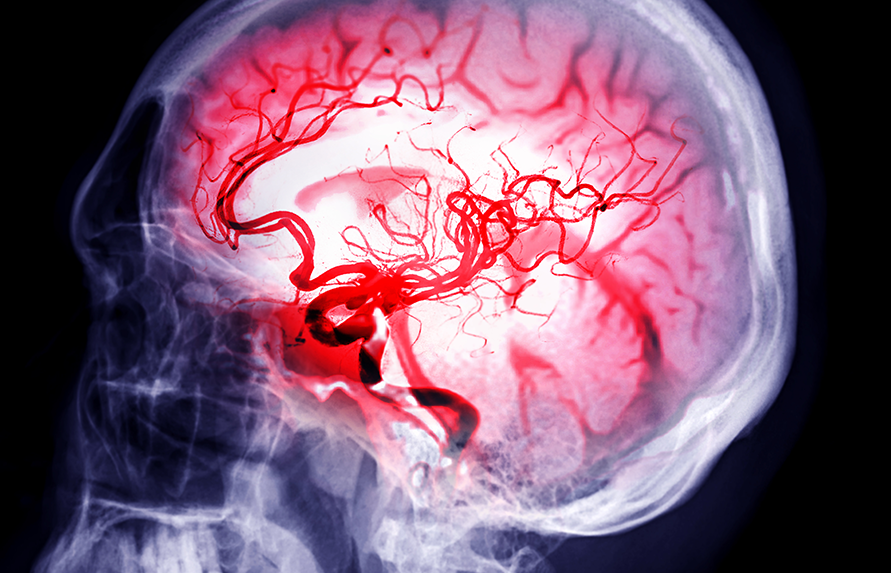The Trending With Impact series highlights Aging publications (listed as “Aging (Albany NY)” by Medline/PubMed and “Aging-US” by Web of Science) that attract higher visibility among readers around the world online, in the news, and on social media—beyond normal readership levels. Look for future science news about the latest trending publications here, and at Aging-US.com.
—
A stroke can occur when the blood supply in and around the brain is interrupted. A hemorrhagic stroke is when a blood vessel bursts in or near the brain. An ischemic stroke is caused when a blood vessel carrying oxygen and nutrients to the brain is obstructed—usually by a clot. The most common type of stroke is ischemic, which accounts for approximately 87% of all strokes in humans. A major risk factor for an ischemic stroke is aging.
Inflammation (a chronic condition among the elderly) is a key contributing factor to strokes, and microglia are the primary immune cells in the brain. Researchers recently identified a role for the microglial IRF5-IRF4 regulatory axis in mediating responses after stroke. However, whether or not aged microglia also undergo the same regulatory mechanisms after a stroke had previously not been determined.
“Microglial activation plays a central role in initiating and perpetuating the post-stroke inflammation, and acts as a ‘double-edged’ sword to confer both detrimental and beneficial effects [9].”
In a recent study, researchers Conelius Ngwa, Abdullah Al Mamun, Shaohua Qi, Romana Sharmeen, Yan Xu, and Fudong Liu from The University of Texas Health Science Center at Houston investigated aged mice and the role of the microglial IRF5-IRF4 regulatory axis after a stroke. On August 12, 2022, their research paper was published in Aging’s Volume 14, Issue 15, and entitled, “Regulation of microglial activation in stroke in aged mice: a translational study.“
The Study
“We have previously found IRF4 signaling is anti-inflammatory and IRF5 is pro-inflammatory in young ischemic microglia [11]. In the present study, we hypothesized IRF4 CKO [conditional knockout] worsens while IRF5 CKO improves stroke outcomes.”
To better understand how microglia responds to stroke in aged individuals, the researchers first investigated microglial IRF5 and IRF4 expression in young and aged mice. A well-established mouse model of ischemic stroke was used in this study. Next, the researchers performed conditional knockout (CKO) of IRF5 or IRF4 in young and aged mice. The study arm mice underwent a 60-minute middle cerebral artery occlusion (MCAO). Stroke outcomes were quantified three days after MCAO.
To evaluate microglial activation and immune responses (surface and intracellular inflammatory markers) post-stroke, the researchers performed flow cytometry and enzyme-linked immunosorbent assay (ELISA). IRF5 CKO aged microglia had significantly lower levels of IL-1β and CD68 compared to controls. IRF4 CKO had significantly higher levels of IL-1β and TNF-α compared to control microglia. Levels of anti-inflammatory cytokines IL-4 and IL-10 were higher in IRF5 CKO, and lower in IRF4 CKO aged mice.
“Plasma levels of TNF-α and MIP-1α were decreased in IRF5 CKO vs. flox aged mice, and IL-1β/IL-6 levels were increased in IRF4 CKO vs. controls.”
Results & Conclusion
Since IRF5 signaling drives microglial pro-inflammatory responses, the researchers hypothesized that microglial IRF5 is detrimental for aged mice in stroke. They also suggested that IRF4 signaling drives anti-inflammatory responses and its expression is protective in aged mice in stroke. Indeed, IRF5 CKO aged mice demonstrated improved stroke outcomes; whereas worse outcomes were seen in IRF4 CKO mice compared to their control counterparts. Furthermore, the results of this study demonstrated that aged microglia express higher levels of IRF5 and lower levels of IRF4 compared to young microglia after stroke.
This study provides valuable insights into how microglial activation is regulated post-stroke, and highlights the importance of the IRF5-IRF4 axis in stroke outcomes. The researchers conclude that the IRF5-IRF4 axis is a promising target for developing novel strategies to treat ischemic stroke. Further research is warranted to determine how these findings can be translated into clinical practice to improve stroke outcomes in the elderly.
“By using the aged IRF4/IRF5 microglial CKO mouse models, the study aimed to selectively suppress microglial pro-inflammatory activation and promote its anti-inflammatory response, and will potentially help develop new, effective therapeutic strategies against stroke.”
Click here to read the full research paper published by Aging.
AGING (AGING-US) VIDEOS: YouTube | LabTube | Aging-US.com
—
Aging is an open-access journal that publishes research papers bi-monthly in all fields of aging research. These papers are available at no cost to readers on Aging-us.com. Open-access journals have the power to benefit humanity from the inside out by rapidly disseminating information that may be freely shared with researchers, colleagues, family, and friends around the world.
For media inquiries, please contact [email protected]

